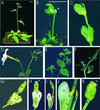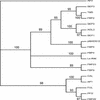The MADS box gene FBP2 is required for SEPALLATA function in petunia
- PMID: 12671087
- PMCID: PMC152338
- DOI: 10.1105/tpc.010280
The MADS box gene FBP2 is required for SEPALLATA function in petunia
Abstract
The ABC model, which was accepted for almost a decade as a paradigm for flower development in angiosperms, has been subjected recently to a significant modification with the introduction of the new class of E-function genes. This function is required for the proper action of the B- and C-class homeotic proteins and is provided in Arabidopsis by the SEPALLATA1/2/3 MADS box transcription factors. A triple mutant in these partially redundant genes displays homeotic conversion of petals, stamens, and carpels into sepaloid organs and loss of determinacy in the center of the flower. A similar phenotype was obtained by cosuppression of the MADS box gene FBP2 in petunia. Here, we provide evidence that this phenotype is caused by the downregulation of both FBP2 and the paralog FBP5. Functional complementation of the sepallata mutant by FBP2 and our finding that the FBP2 protein forms multimeric complexes with other floral homeotic MADS box proteins indicate that FBP2 represents the same E function as SEP3 in Arabidopsis.
Figures




References
-
- Alvarez-Buylla, E.R., Pelaz, S., Liljegren, S.J., Gold, S.E., Burgeff, C., Ditta, G.S., Ribas de Populana, L., Martinez-Castilla, L., and Yanofsky, M.F. (2000). An ancestral MADS-box gene duplication occurred before the divergence of plants and animals. Proc. Natl. Acad. Sci. USA 97, 5328–5333. - PMC - PubMed
-
- Ambrose, B.A., Lerner, D.R., Ciceri, P., Padilla, C.M., Yanofsky, M.F., and Schmidt, R.J. (2000). Molecular and genetic analyses of the Silky1 gene reveal conservation in floral organ specification between eudicots and monocots. Mol. Cell 5, 569–579. - PubMed
-
- Angenent, G.C., Franken, J., Busscher, M., Colombo, L., and Van Tunen, A.J. (1993). Petal and stamen formation in petunia is regulated by the homeotic gene Fbp1. Plant J. 4, 101–112. - PubMed
Publication types
MeSH terms
Substances
Associated data
- Actions
- Actions
- Actions
- Actions
- Actions
- Actions
- Actions
- Actions
- Actions
- Actions
- Actions
- Actions
LinkOut - more resources
Full Text Sources
Other Literature Sources
Molecular Biology Databases

